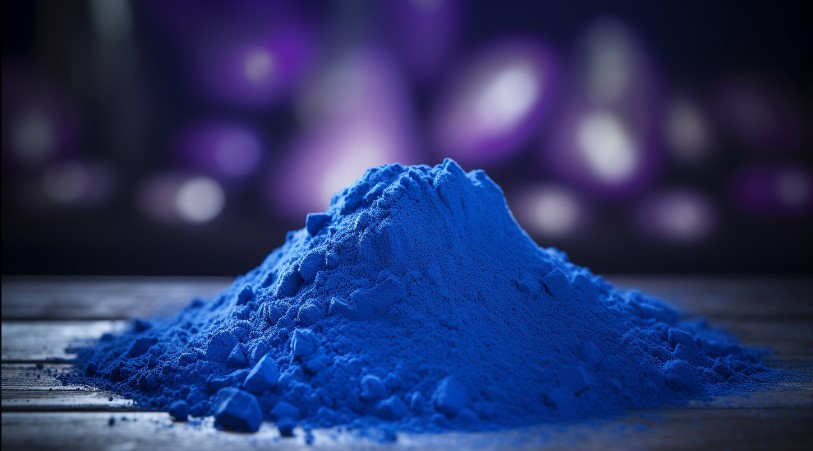피코시아닌 - 식품 첨가물 산업의 잠재적 자원

Phycocyanin is a dark blue powder isolated from spirulina. It is mainly found in cyanobacteria, red algae and crypto-algae. Phycocyanin is also commonly divided into C-phycocyanin and R-phycocyanin, the former mainly found in cyanobacteria, the latter mainly found in red algae, and both in crypto-algae. Its function is to absorb light (orange yellow) energy and transfer light energy. It is not only a protein, but also an excellent natural food coloring, but also a good health food.
In Europe, phycocyanin is used as a color food ingredient in unlimited quantities. In countries such as China, the United States, Japan and Mexico, phycocyanin is used as a source of blue in various food and beverages. It is also used as a colorant for nutritional supplements and pharmaceuticals, with added amounts ranging from 0.4g to 40g/kg, depending on the desired color depth of the food.
Natural pigments for food
Phycocyanin, as a natural pigment, has been widely used in food and cosmetics in Europe, America, Japan and other countries and regions in the early 21st century. Phycocyanin is a natural blue pigment approved by the United States FDA, and is also included in the European Union’s color food raw materials, and there is no limit on its use. China’s GB2760 food additives catalog also uses algin blue as a natural colorant, allowing it to be used in candy, fruit and vegetable juice, flavored beverages, and jelly products.
How do food companies play with phycocyanin
According to the data, the global natural food coloring market was estimated at $3.88 billion in 2018 and is expected to reach a compound annual growth rate of 5.7% to $5.12 billion by 2023. Compared to synthetic food colors, natural food colors provide more options for food processors, and many artificial color suppliers have turned to the development of natural colors.
At present, in addition to the sharp growth in the demand for natural red pigments and natural yellow pigments, the market capacity of natural blue pigments is also very huge. The global market is expected to grow at an average annual rate of 50% from 2016 to 2020. If phycocyanin is added to the aqueous solution, it can show a clear sky blue, so it is favored by enterprises.
Nestle’s classic candy -Smarties
In 2010, Nestle tried using spirulina extract as a source of blue in Smarties, but the experiment never made it to market due to regulatory restrictions. In 2013, food giants such as Mars and Nestle submitted permission to the FDA to use spirulina extract as a pigment in food. With the advance of regulations, Nestle fully replaced FD&C Blue No.1 (bright blue) in Smarties with phycocyanin as the source of blue in candy. Now, in most countries such as Europe and Singapore, consumers can taste Smarties blue candies colored with phycocyanin.
and road snow
Each Yummies ice cream hides a number of delicious secrets: juicy fudge, gluten-free, no artificial colors, and natural flavors.
In addition to Yummies, and Lu Xue also launched Paddle Pop Twister Mermaid, Paddle Pop Rainbow, Wall’s Classic Paddle Pop Rainbow. Both added spirulina extract as a source of blue.
HERSHEY’s cookies mint- The charm of using phycocyanin compounding
HERSHEY is one of the largest chocolate manufacturers in the world. Hershey’s Cookies Mint (Hershey’s Mint chocolate) was first introduced in 1994 and has been discontinued several times before returning in 2020.
Instead of making the chocolate a radical blue color, Hershey chose to use phycocyanin and turmeric to make it green, which also caters to the flavor of the chocolate – mint, a piece of blue minty chocolate would obviously feel strange.
Phycocyanin, as a rare blue pigment in natural pigments, has become a common source of natural coloring in food after nearly ten years of application in the European and American markets. Not only food giants such as Mars, Nestle, Unilever, and Coca-Cola, but many small and medium-sized enterprises use phycocyanin as a source of blue, green, and even purple in their products.
Health food field
Studies have shown that phycocyanin can scavenge free radicals. As a natural antioxidant, phycocyanin can help remove cell damage and aging caused by harmful free radicals in the body.
Cosmetics field
Phycocyanin is a collagen-like protein with whitening and moisturizing effects. Some cosmetics brands at home and abroad have applied phycocyanin raw materials in their customized cosmetics products.
photosensitizer
In addition, because phycocyanin has fluorescence properties, its fluorescence effect is 30 times that of ordinary fluorescein, and it can be used as a photosensitizer in some photodynamics such as biology and cytology. At the same time, as a photosensitive protein, phycocyanin can also significantly promote plant photosynthesis and produce photosensitive reaction, so that the product has antiviral effect.
In a future where plant power and health needs are increasingly valued, the potential of algae is bound to be noticed and more power will be injected into it. At the same time, it is more important to achieve more rigorous scientific research on algae and breakthroughs in algae production and development technology. Only by improving scientific research and technology can the potential of algae be truly realized.
Phycocyanin supplier: www.backvita.com
이메일: [email protected]
전화 +86 (029) 8187 2325
